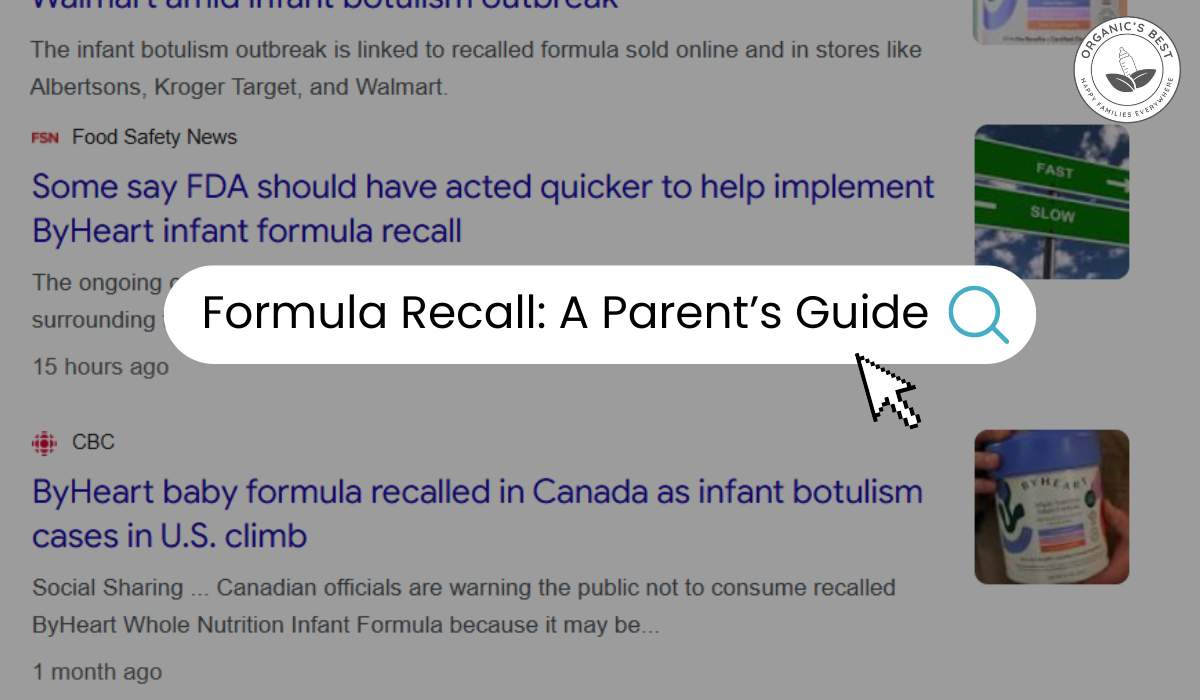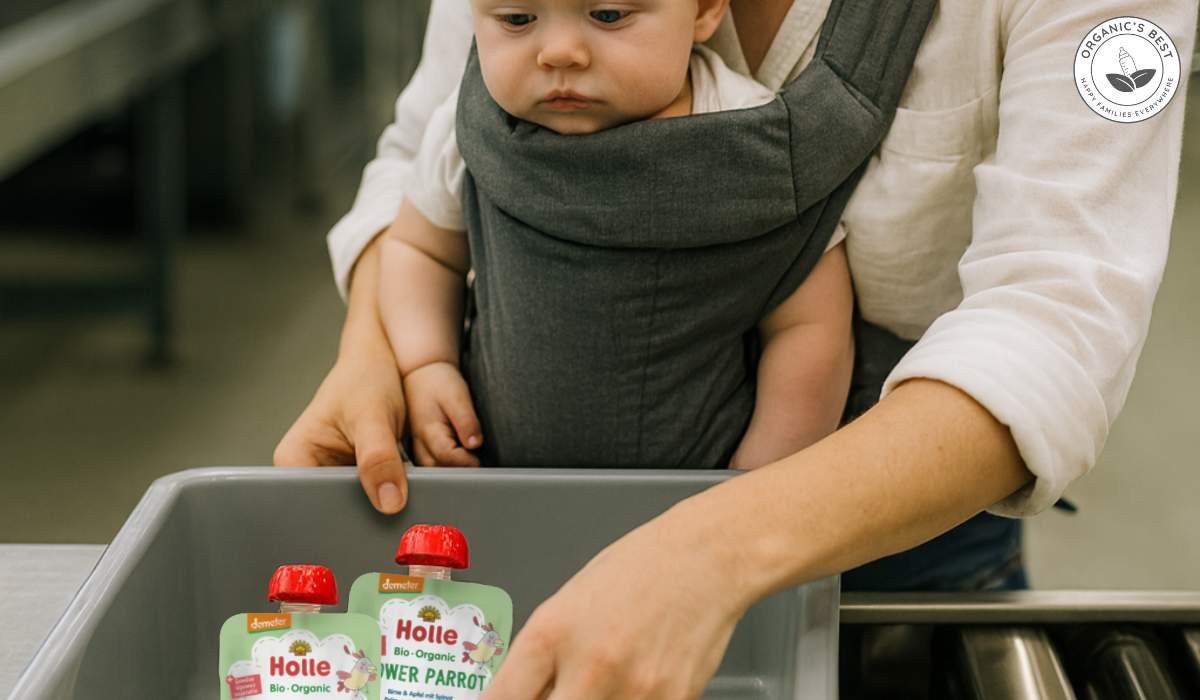Click to Get 2 FREE Boxes/Cans
Click to Get 2 FREE Boxes/Cans
Only New Customers! Click HERE to Get 2 Extra Boxes/Cans for Free With Your First Order.
Only New Customers! Click HERE to Get 2 Extra Boxes/Cans for Free With Your First Order.
BABY FORMULA
Offering new parents top-quality European infant formula from renowned brands like HiPP, Holle, Kendamil, and more. If you’re uncertain about which product to choose, our Formula Finder can help you make the best decision for your baby.
Baby Food
Offering new parents a premium selection of European baby foods, including jars, pouches, cereals, and snacks from esteemed brands like HiPP and Holle.
How Many Calories in Breast Milk?
by Agustina Fernandez August 13, 2024 9 min read

Curious about the nutritional powerhouse that is breast milk? Since your little one relies on calories to grow and thrive, it's natural to wonder just how many calories in breast milk there are!
Calories, which are the units used to measure the energy in food and beverages, play a huge part in fueling your little one's daily functions.
Interestingly, the fat and, therefore, the calorie content of human milk will fluctuate throughout the day and over time, adapting to your baby's needs as they grow from newborn to toddler.
As a baseline, human milk contains roughly 3.8 grams of fat and 60-75 calories per 100 ml, although these values can vary based on a mother's health and nutrition.
Keep reading to learn more exciting breast milk nutrition facts, including the nuances that affect how many calories are in breast milk, what breast milk is made of and how it supports your baby's growth and development!
Table of Contents
- Breast Milk Calories Per Ounce
- Infant Calorie Needs in the First Year of Life
- Why is Fat in Breast Milk Important for Your Baby?
- The Science Behind Foremilk and Hindmilk
- Factors That May Affect Calories in Breast Milk
- How to Know if You Need Fattier Breast Milk
- Increasing Calories in Breast Milk: How to Make Breast Milk More Fatty?
- How Can You Consume More Calories While Breastfeeding?
- Conclusion on The Caloric Value of Breast Milk
Breast Milk Calories Per Ounce
Let's start by answering the question, "How many calories does breast milk have?". The quick answer is that healthy human milk contains approximately 19-22 calories per ounce.
However, to fully explain how many calories in an ounce of breast milk, we must break it down by the type of milk because calories can vary depending on whether you are producing colostrum, transitional milk, or mature milk.
Colostrum is a special kind of milk secreted only in the first couple of days post-birth that provides fewer calories in breast milk per oz. It is only secreted in small amounts and appears yellowish in hue, which has earned it the title of 'liquid gold.' Colostrum contains higher levels of protein, minerals, and fat-soluble vitamins (such as A, E, and K) than standard human milk. It is also an abundant source of white blood cells and antibodies supporting infant immunity.
Transitional milk, on the other hand, has a calorie content that will slowly increase before an evening out about 10-15 days after birth, when you begin producing mature milk.
Mature milk contains an average of 20 calories per ounce. The higher calorie content supports your baby's rapid growth and increased energy needs as they develop. In contrast, colostrum's lower calorie content is balanced by its rich concentration of immune-protective factors critical for the newborn's initial days.
Infant Calorie Needs in the First Year of Life
An infant's calorie intake will range from around 500-770 calories from breast milk per day. Their exact calorie needs will depend on various factors, including age, weight and length, and sex. Notably, males will have a slightly higher caloric need than females.

Here is a quick summary of how many calories a baby needs based on sex and age:
Boys ♂️
1-3 months = 472-572 calories per day
4-6 months = 548-645 calories per day
7-9 months = 668-746 calories per day
10-12 months = 793-844 calories per day
Girls ♀️
1-3 months = 438-521 calories per day
4-6 months = 508-593 calories per day
7-9 months = 608-678 calories per day
10-12 months = 717-768 calories per day
Why is Fat in Breast Milk Important for Your Baby?
You may be wondering, what is breast milk made of? Human milk is naturally abundant in fat, with the majority of calories in breast milk coming from this macronutrient.
The fat composition of breast milk can vary between women as it's impacted by their general health and nutrition. Still, in general, the fat content in human milk will typically range from 3%-5%.

This rich fat content contributes to an infant's overall health by:
-
Providing essential nutrients and energy in their first year of life
-
Helping babies achieve their growth milestones through healthy weight gain
-
Supporting vision, nervous system, hormone, and digestive system development
-
Long-chain polyunsaturated fatty acids (LCPs) content, particularly docosahexaenoic acid (DHA), contribute to healthy brain development
-
Aiding in the absorption of fat-soluble minerals like calcium and magnesium
-
Decreasing the chance of constipation
-
Lowering the risk of adulthood obesity
-
Reducing unhealthy inflammation in the body
-
Providing immune system support
-
Supporting digestion and metabolism of energy sources, like carbohydrates and proteins
As you can see, the fat content in human milk has countless advantages when it comes to the health and well-being of your baby. Did you know that in addition to being an optimal source of nourishment, the fat in human milk also enhances the taste of breast milk, adding a creaminess and richness that babies are naturally drawn to?
The Science Behind Foremilk and Hindmilk
Your milk doesn't only evolve as your baby grows, it also changes throughout a single feeding, but what is foremilk and hindmilk?
The truth is that both types of human milk are important to your baby's growth and development, but when it comes to the fat content, only one comes out on top.

Foremilk: This type of milk is produced at the start of feeding and consists mostly of water and other nutrients. Due to the higher water content, foremilk is thinner and is perfect for quickly filling up a hungry baby. However, just consuming foremilk won't keep your baby satisfied for long, so it's important to nurse long enough for your baby to receive hindmilk.
Hindmilk: Towards the end of a feeding (after around 10-15 minutes of nursing), hindmilk is secreted. This type of milk is richer thanks to its higher level of healthy fats. It plays a key role in keeping your baby satisfied, as it is thick, creamy, fatty, and overall, the perfect nourishment for a growing baby!
If you are wondering how to make fattier breast milk, the answer lies in how often you feed your baby. When you nurse your little one faster than your breast milk replenishes, your baby is more likely to primarily consume hindmilk. We discuss methods for boosting the fat content and, therefore, average calories in breast milk later on.
Factors That May Affect Calories in Breast Milk
Several diet and lifestyle choices and a mother's overall health status can influence her breastfeeding calories. These factors include:

-
Maternal diet: A well-balanced diet rich in healthy fats, proteins, and carbohydrates can enhance the caloric density of human milk.
-
Medication: Some medications might reduce milk supply or alter its nutrient content, affecting the overall calorie count.
-
Vitamin deficiencies: Deficiencies in essential vitamins can affect the nutritional quality of breast milk. For instance, a lack of certain vitamins might reduce the effectiveness of nutrient transfer to the milk, impacting its caloric and nutritional value.
-
Age of mother: Metabolic rate and hormonal balance can vary with age, potentially influencing milk production and its caloric content. Younger mothers might have different metabolic demands and milk compositions compared to older moms.
-
Delivering a preterm infant: If your baby was born preterm or has a low birth weight, your body may adjust to produce milk with different nutrient compositions to meet the baby's needs. This is because preterm infants need more calories and nutrients for catch-up growth, prompting your body to adjust your milk composition to meet these demands.
-
Maternal obesity: Maternal obesity can affect hormone levels and milk production. Obese mothers might produce milk with different fat content, which can influence the overall caloric density of the breast milk.
-
Smoking: Nicotine and other chemicals can affect the nutrients in breast milk, potentially lowering its caloric value and nutritional quality.
How to Know if You Need Fattier Breast Milk
First things first, if your baby is not growing at an appropriate rate despite frequent feeding sessions, it's time to consult a pediatrician or lactation consultant, who can provide personalized guidance based on your circumstances. This is especially important if your baby shows signs of losing weight after the first week of life.
While it is normal and expected for a baby to lose small amounts of weight throughout that first week, they should begin to put on weight after this period. If that's not the case, you may need to try increasing the fat content of your breast milk, and a healthcare professional can guide you through best practices for this.
Clear signs that your baby isn't getting enough fat in their diet include getting cold more easily, as fats are essential for maintaining and regulating body temperature.
Increasing Calories in Breast Milk: How to Make Breast Milk More Fatty?
If your little one isn't growing at the expected rate, you may be wondering how to increase calories in breast milk or how to get fatty breast milk. The solution often involves making changes to your diet.
As previously mentioned, a mother's diet directly impacts the quality of her milk, affecting the types of saturated, trans, monounsaturated, and polyunsaturated fats it contains. Som, if you want to increase fat in breastmilk, here are some tips to follow:
Include More Healthy Fats into Your Diet
Eating a well-balanced diet, high in healthy unsaturated fats, can not only increase the quality of your breast milk, but it can also improve your own health. On top of adding more unsaturated fats into your diet, try to also limit saturated and trans fats, as these can cause inflammation and high cholesterol.

Try adding these fatty foods to your diet:
🥑 Avocados
🫒 Olive oil
🐟 Salmon
🥜 Seeds and nuts
Eat Enough Calories
Breastfeeding can certainly work up an appetite, which is your body's way of signaling its need for more calories during lactation. In addition to the energy your body requires for its daily functions, you'll need extra calories to support your baby's nutritional needs.
If your body doesn't receive enough calories to meet both your own needs and those required for milk production, it can affect the quality of the milk and leave both you and your baby feeling hungry.
Eat More Protein
Getting enough protein in your diet increases milk production, leading to full breasts ready to be emptied regularly.
A solid milk supply can establish an abundant production of fattier breast milk, so try eating protein-rich foods like lean meats, fish, and poultry.
If you'd prefer vegetarian options, eggs, dairy, legumes, tofu, and tempeh are also great protein sources!
Prioritize Drinking Enough Water
Breast milk is more than 80% water! So, staying on top of hydration is imperative while breastfeeding. Your body simply cannot produce enough milk if you are not drinking enough water.
Use a Breast Pump
If you are looking to increase milk production, a breast pump can be a valuable tool to get your milk flowing.
A great tip for mothers wanting to up their baby's fat intake is to pump out the thinner foremilk at the beginning of the feeding and then have the baby start nursing once the rich and fatty hindmilk starts flowing. In this case, you can safely store your pumped foremilk for later use.
Fortify Breast Milk with Infant Formula
If you find yourself unable to produce enough milk to support your baby's nutritional needs fully, you can supplement with formula to add calories and nutrients to a feed.
However, combination feeding can negatively impact your breast milk supply, so ensure you maintain regular milk expression to safeguard your milk production. Moreover, it's essential to prepare formula according to the instructions provided by the manufacturer before mixing it with breast milk.
Ultimately, it's best to seek the advice of a qualified healthcare professional before introducing formula to your baby's diet. Oftentimes, breastfeeding issues can be addressed with the support of a lactation consultant.
How Can You Consume More Calories While Breastfeeding?
A breastfeeding mama needs more daily calories to support her body and baby. An optimal diet for breastfeeding nutrition will include an extra 450-500 calories per day.
Including some of the aforementioned proteins and healthy fats, as well as a variety of whole foods and fresh fruits and veggies, into your diet can make a world of difference when it comes to producing rich, fatty milk for your baby.
Conclusion on The Caloric Value of Breast Milk
Whether you're concerned about your milk supply or your baby's growth, it's normal to wonder if your breast milk contains enough fat and how many calories in breast milk there are. Now that you have answers to common questions-such as how many calories per ounce of breast milk, what's in breast milk and how to increase fat in breastmilk-you can apply this knowledge to enhance your milk quality. Remember, your milk has the ability to provide everything your baby needs for the first year and beyond!
|
Disclaimer:
Please be aware that this information is based on general trends in babies, and it is not medical advice. Your doctor should be your first source of information and advice when considering any changes to your child’s formula and when choosing your child’s formula. Always consult your pediatrician before making any decisions about your child’s diet or if you notice any changes in your child. Breastfeeding is the best nutrition for your baby because breast milk provides your child with all the essential nutrients they need for growth and development. Please consult your pediatrician if your child requires supplemental feeding. |
Agustina Fernandez
Dr. Agustina Fernandez earned her medical degree from the prestigious Universidad Nacional de Córdoba, Argentina. With a deep-rooted passion for pediatrics, Dr. Fernandez is currently on the path to specializing in children's healthcare. Recently, she has delved into the vital field of infant nutrition. Her research interests include breastfeeding, infant formula, and baby food in little ones’ formative years. Dr. Fernandez's commitment to this area of study underscores her dedication to ensuring the health and well-being of children from their earliest days.
Leave a comment
Comments will be approved before showing up.
Also in Organic Infant Nutrition and Health Blog

All You Need to Know About Formula Recall: A Parent’s Guide
by Agustina Fernandez December 23, 2025 8 min read
Read More
Everything You Need To Know About Winter Pregnancy: Essential Tips for Moms-to-be
by Agustina Fernandez December 16, 2025 8 min read
Read More
Can You Bring Baby Food Pouches on a Plane? Essential Tips for Parents
by Agustina Fernandez December 09, 2025 7 min read
Read More
Reviewed by Dr. Po-Chang Hsu, MD, MS
-

Dr. Po-Chang Hsu: Medical Reviewer of Organic's Best Blog
Dr. Hsu received his medical degree from Tufts University in Boston, Massachusetts, and holds a Master’s of Science degree from both Harvard University and Tufts University.
